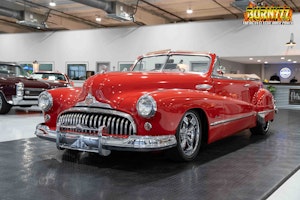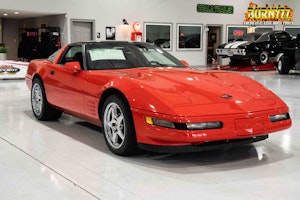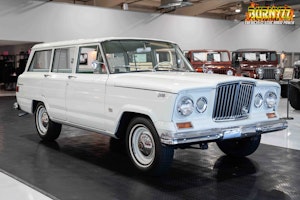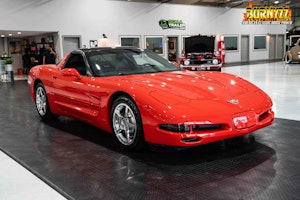Media | Articles
Project Saab 9000 Aero update: Should you be Eucalyptus Green with envy?
Okay, ignore the worst article title you’ve ever read and just give me a second. The last time we checked in on the ’94 Saab project, it was at Sports Car Service in Delaware having a host of drivability and safety issues resolved. The result? For the first time in many years, this beautiful box has working ABS, operational cruise control, an accurate boost gauge and tachometer to keep one aware of the various red zones, new shift linkages, functional air-conditioning, and more.
Most issues were addressed by fresh sensors, decent-condition used parts, and a handful of NOS switches and parts the shop had stowed away on a dusty shelf. The technicians also threw on the fresh set of Michelin Pilots that were drop-shipped to them a few months ago. Finally, the car satisfied the minimum criteria for joining the Phillips rotation.
In mid-March, I hatched my extraction plan, which would also enable me to kill several birds with one stone. You see, Sports Car Service had offered to recharge the air-conditioning system, which had gone warm, on my right-hand-drive Toyota Century. Under cover of early-morning darkness, the journey began. Leaving Maryland in the Century at roughly 5:00 a.m., I arrived at the shop in Delaware by opening time and swapped cars, then headed immediately in the Aero to the Philadelphia airport, which was about 30 minutes away, to catch a flight for work. Easy, right?
It was a typical I-95 kind of morning between Wilmington and Philadelphia, so, instead of exploring the right side of the boost gauge, I took the opportunity to get comfortable with the cabin and get the general feel of the now-sorted vehicle. Hey, the wipers worked. I had no warning lights. It tracked straight, clutch engagement and shifting felt good, the climate-control system was keeping everything de-misted and comfortable, and the Clarion factory radio/EQ setup was perfect. It felt great and, at this moment, I was in the car for somewhere around what, five grand? Let’s hear it for inexpensive nostalgia!
A few days later and a few more hours down an uneventful highway, the car was home in my garage where I could really start to dive into the details. The paint was … sheesh, pretty bad upon close inspection, at least on the upper surfaces. I think that at some point in this car’s life, it was relegated to storage under a car cover in a driveway, which can lead to a lot of abraded paint if grit sneaks between car and cover, and various weather elements jostle the two together—think Brillo pad. The hood has a lot of deep scratches and swirls, and the roof has apparently been repainted (and not very well). I knew the paint needed attention, and I had hoped that some buffing would bring the Eucalyptus Green back to its proper sheen, but I’m not so sure about that. Looks like a paint job will be in order this upcoming winter!
Marketplace
Buy and sell classics with confidence
Seriously, why do I really care about the paint? I bought the Saab because it’s one of the major sleepers of the modern age! Frankly, the blasted paint makes it even more stealthy.
FINALLY, let’s talk about the performance I have been able to experience thus far. Holy Mother of Thor, this thing moves. Even in stock 225-hp form, a 9000 Aero will pull 0–60 in a little over 6 seconds and run out to 150 mph—roughly the same figures as my stock ’87 3.2 Carrera. Not bad for a luxury-laden, five-door hatchback. This Aero, however, has been modified with a 3-inch downpipe and an exhaust system that would look more at home on a Bluebird school bus. Throw in a modified ECU to drive the engine management controls, and supposedly this Swede is pushing 280 hp. I’m happy to report that, thanks to the turbo, it really doesn’t seem any louder than stock from the inside, but my wife does say she knows when I’m coming around the block.
Hey, it’s not as obnoxious as my ’66 Tiger with the blown-out glasspacks, so we’re still winning.
What I can verify, though, is that when you run up through the gears, and the boost gauge goes to the right of center, you get pushed wayyyyyy back into that extra-huggy Recaro. The torque peaks at around 2000 rpm and stays there all the way to 5500, so you never get the sensation that the car “comes alive” at any particular rpm; it provides maximum thrust the entire way around the speedometer. It is an interesting sensation, really, and the purposeful gearing of the car enhances the effect. I knew the car must have a pretty tall fifth gear to achieve that magical 30 mpg highway rating, but Saab did one better: The top TWO gears of the five speed are overdriven, so the 9000 simply loafs along on low-end torque everywhere you go.
Need some power to pass? You have two choices. One, leave it lazily in the gear you’re cruising in and squeeze the throttle. The boost gauge will move from left to right, and you’ll pull smoothly ahead. No drama. Let’s say you like a little drama, and you’ve got a clear road ahead. Dropping down out of those double overdrives makes things a lot more interesting. In my view, third gear is the one that makes this legendary highway-hauler the most fun. Presented by the rear end of a dawdling line of tractor-trailers going 50 mph? Have no fear. Simply drop from fifth to that magic third gear and stand on it. You’ve got a powerband that can take you to a shade over 100 mph without needing to upshift, and all you have to do is get around ’em with a big smile on your face. Using my infallible seat-of-the-pants estimation, 50–100 mph and back to a Waze-friendly 65 takes about two seconds. Okay, three seconds. Whatever—it’s fast.
It’s not all wine and roses, though. I discovered an unintended consequence of mounting these fine Michelin Pilot VR-rated tires. In early testing, when I approached max boost between 4000 and 5000 rpm in first and second gear, the Saab would haze the old tires and keep on pulling. Now it has so much tire grip that the fuse in the system transfers to the stock clutch assembly, necessitating a little feathering of the throttle in the upper-rpm ranges in those gears. I have no idea when the clutch was last changed, so it’s possible that simply putting a stock one back in it will be fine; that said, there are plenty of higher-grip options out there if need be. No matter for now, it’s just another thing added to the list. Speaking of which, I’ve been knocking out some basic maintenance items in my own garage that have been quite satisfying—like changing every spark plug and filter the car has!
Spark plugs had been in there a while, and swapping them for a new set of NGK 1095s seemed to settle a little roughness at low rpm. It took only four little bolts to move the ignition cassette out of the way, and the plugs came right out. They all looked about the same—dry on the electrodes but a little oily around the threads.
The engine itself looks like an old Alfa Romeo without all that modern stuff on top. Pretty fitting, since the Saab 9000 platform was also used for the Alfa 164, among a few others …
While nothing terribly gunky had appeared, replacing the Bosch fuel filter seemed like a no-brainer. You have to jack up the car to access it, but it’s really not a terrible job at all. Depressurizing the fuel system by pulling the fuel-pump fuse and letting the car run itself dry keeps a lot of stinging fuel out of your eyes and armpits when you crack those lines, believe me.
Don’t forget that hidden cabin air filter if your car has one, either. I think the climate-control system will be breathing a little easier, as will my passengers!
The point of all this is to get the car ready for some automotive adventures, right? The first one is the annual Amelia Island or Bust tour, which begins May 15 outside of Baltimore, Maryland. We’ll be exercising the Aero with 25 other cars on every twisty back road we can find for 1200 miles.
The Saab will not only be part of the Swedish Meatballs display at this year’s Concours d’Lemons on Saturday, May 22, but it will also be driven 1200 miles to the event by the founder of Lemons himself, Alan Galbraith (pictured below, though with a more high-brow vehicle). I can’t think of a more fitting combination of man and machine; both Alan and the Saab are larger-than-life and ready for adventure.
Hopefully our next report doesn’t involve a smoked clutch and a trip on a flatbed. We’ll also get some much-needed footage of this sucker in action on the way! Make sure to come say hello if you’re attending the Concours d’Lemons—we always have a lot of fun. See you on the road!






































Any interest in Selling you Saab?
Lovely story, but you make the comment ‘The engine itself looks like an old Alfa Romeo without all that modern stuff on top. Pretty fitting, since the Saab 9000 platform was also used for the Alfa 164, among a few others …’ It is not an Italian engine, SAAB bought the rights to a British Triumph slant-4 car engine used in a few cars back in the late 70s/80s. Overtime this engine was much re-engineered by SAAB and by the time of the 9000 about the only thing it resembled from the original Triumph engine that it was still a ‘Slant Four’ that’s about it.